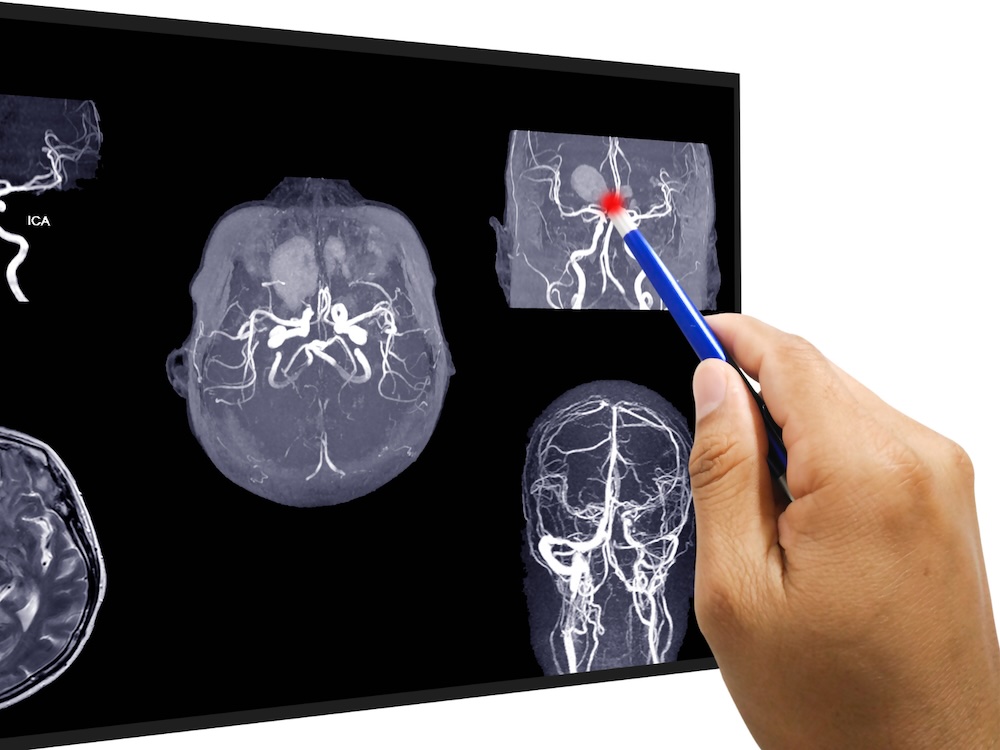Imagine a small balloon growing within the walls of your blood vessel in your brain. That’s what happens when an intracranial aneurysm forms.
An unruptured aneurysm does not usually cause any symptoms unless it starts to leak. If that happens, you may experience headaches, double vision or eye pain. If the aneurysm bursts, it leads to bleeding within the brain. This may start with the worst headache you’ve ever experienced and can lead to a serious stroke. At this point, the ruptured aneurysm needs to be secured which could be done in various ways. You may need emergency surgery and close monitoring in a neurosurgical intensive care unit.
How do you detect a brain aneurysm before it ruptures?
If you’re experiencing symptoms such as pain behind the eye, headaches or double vision, your doctors may try to find out if you have an aneurysm. This can be done using a series of tests, such as specialised scans (CT or MRI), angiograms.
If you do have an unruptured brain aneurysm, your doctors may then assess whether your aneurysm is likely to rupture. If it is unlikely to rupture, we may recommend:
- Watchful waiting (where we keep a close eye on you through regular tests)
- Surgical treatment – either endovascular treatment or surgical clipping.
For the rest of this article, we will focus on surgical clipping.
Clipping an intracranial aneurysm
Aneurysm clipping is a surgical procedure where a small metal clip is placed at the base of the aneurysm where it stays for the rest of your life.
The clip stops blood flowing into the aneurysm, meaning it can’t grow any further. Deprived of blood, the aneurysm slowly shrinks.
Aneurysm clipping procedure
It’s natural to be nervous about the thought of brain surgery so we hope understanding the process may help ease your concerns a little.
Here’s how the procedure typically works, step by step:
1. Pre-surgery preparation
Before surgery, you’ll meet with your surgical team to discuss the risks and benefits of aneurysm clipping and give you chance to ask any questions you may have.
After that, you’ll have imaging tests like CT or MRI scans. These tests help us pinpoint the exact location of your aneurysm and plan how to get to it.
2. Aneurysm clipping
When it’s time for your surgery, you’ll be given a general anaesthetic to put you to sleep.
We then perform a craniotomy, removing a piece of your skull so we can access your brain aneurysm.
Using high-powered microscopes for visibility, we carefully locate the aneurysm and place a small titanium clip at its base to block the blood flow.
Once that’s done, we finish the surgery, replace the piece of your skull and sew the muscles and skin back together.
3. Recovery
After your surgery, you’ll spend several days in hospital where we can monitor you closely. Once you’ve been discharged, you’ll continue to recover for several weeks at home.
You may experience headaches, fatigue and some swelling after surgery but these symptoms should ease over time.
It’s important to follow any instructions you’re given for post-operative care and to attend follow-up appointments.
Risks and benefits of clipping an aneurysm
The benefits of aneurysm clipping are that it:
- Greatly reduces the risk of the aneurysm rupturing, protecting your life and health and giving you peace of mind
- Is permanent – once the clip is in place, no further action is usually needed
- Is a versatile treatment option, able to treat larger aneurysms in challenging areas of the brain
- Has a proven track record as it has been used for many years.
As with any surgical procedure, there are risks as well as benefits. In this case, the risks may include:
- Risks common to all surgeries such as reaction to the anaesthesia, infection, bleeding or clotting
- Pneumonia
- Stroke
- Seizures
- Muscle weakness
- Brain swelling or bleeding (subdural haematoma)
- Leakage of cerebrospinal fluid
- Water in the brain (hydrocephalus)
How can we help?
Macquarie Neurosurgery and Spine features an extensive team of highly skilled neurosurgeons experienced in aneurysm clipping.
If you or a loved one is facing an aneurysm diagnosis, please book an appointment to determine the best treatment plan to reduce the risk of rupture.
Disclaimer
All information is general and is not intended to be a substitute for professional medical advice. Macquarie Neurosurgery and Spine can consult with you to confirm if a particular treatment or procedure is right for you. Any surgical or invasive procedure carries risks. A second opinion may help you decide if a particular treatment is right for you.
References
- Johns Hopkins Medicine, Cerebral aneurysm, https://www.hopkinsmedicine.org/health/conditions-and-diseases/cerebral-aneurysm#:, [Accessed 24 October 2024]
- Mayo Clinic, Brain aneurysm, https://www.mayoclinic.org/diseases-conditions/brain-aneurysm/diagnosis-treatment/drc-20361595, [Accessed 24 October 2024]
- Johns Hopkins Medicine, Unruptured brain aneurysm, https://www.hopkinsmedicine.org/health/conditions-and-diseases/unruptured-brain-aneurysms, [Accessed 24 October 2024]
- National Library of Medicine, Brain aneurysm repair, https://medlineplus.gov/ency/article/007372.htm, [Accessed 24 October 2024]
- Healthline, Overview of clipping surgery for a brain aneurysm, https://www.healthline.com/health/brain-aneurysm-clipping-surgery#purpose, [Accessed 24 October 2024]






